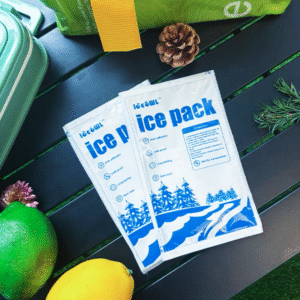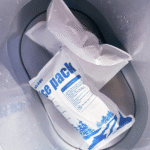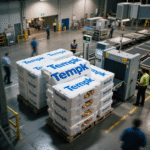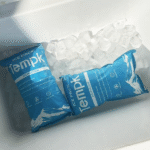Feuille de pack de glace carbonique: 2025 Budget & Guide de dimensionnement
Si vous prévoyez des envois à froid 2025, un coût de la feuille de glace carbonique peut réduire les frais, simplifier la conformité, et stabiliser les températures. Ce guide montre comment fixer le prix de la feuille, dimensionnez-le à votre voie, et modéliser le coût réel au débarquement. Exemples de lots de marché allant des petits emballages multiples aux cartons en vrac, avec des prix unitaires en forte baisse en fonction du volume – contexte vital lorsque vous expédiez de manière hebdomadaire ou saisonnière.
-
Facteurs de coûts: Matériels, taille, et le volume qui déterminent le prix de la feuille de glace carbonique.
-
Quand le choisir: Cas d'utilisation où les feuilles battent les packs de gel ou les pellets de glace carbonique.
-
Dimensionnement & validation: Modèles de pack-out et modèle de coûts rapide que vous pouvez copier.
-
Tendances 2025: Ce qui change dans les réfrigérants, conformité, et capteurs.
Qu'est-ce qui détermine le coût du budget des feuilles de glace carbonique dans 2025?
Réponse courte: Les matériaux et la taille de la commande dominent votre budget de feuilles de pack de glace carbonique. La résine SAP et les supports non tissés fixent le prix de base, pendant que l'on filme, assemblée, QA, et l'emballage ajoute des parts plus petites. Le coût unitaire diminue de 30 à 60 % lorsque vous passez des emballages multiples au détail aux achats sur palettes. Pour la planification, attendez-vous à des produits réutilisables à un prix plus élevé, mais à un coût par utilisation inférieur au fil du temps.
Coût_Dry_Ice_Pack_Sheet_2025
Pourquoi ça compte pour toi: Vous payez pour l'absorption, durabilité, et format. Des couvertures à vingt-quatre cellules enveloppent les produits et réduisent les points chauds, réduire les pertes de produits. Les feuilles réutilisables répartissent les coûts sur des dizaines de tours. Jetable, les options à deux épaisseurs privilégient les voies à sens unique. Typique 2025 exemples: pack de six ≈32,95 $ US; pack de douze ≈59,95 $ US; 250‑pack ≈759 $ US; 428‑compter deux épaisseurs ≈US$435.99. Utilisez-les comme points de référence lors de l’analyse comparative des devis.
Coût_Dry_Ice_Pack_Sheet_2025
Matériaux qui modifient le prix des feuilles de glace carbonique
Détails: SÈVE (polymère superabsorbant) favorise l'absorption d'eau et la libération de froid. Le non-tissé PP ajoute de la résistance et de la transpiration. Les films extérieurs améliorent l’intégrité du joint et la résistance à la perforation. Réutilisable, les constructions multicouches coûtent plus cher au départ mais survivent au lavage et à la recongélation, réduction du coût par cycle – utile pour les itinéraires en boucle fermée.
Coût_Dry_Ice_Pack_Sheet_2025
| Nomenclature & Signaux | Part typique | 2025 notes | Ce que cela signifie pour vous |
|---|---|---|---|
| Résine SAP (polyacrylate de sodium) | 35–55% | Payez en fonction de la capacité et de la qualité | Part SAP élevée → sensibilité au prix |
| Substrat non tissé | 15–25% | Le Spunbond PP est courant | Impacte la durabilité et la transpiration |
| Film/stratification | 10–20% | Mélanges PE/PET | Affecte la résistance aux fuites, imprimable |
| Assemblée & QA | 5–10% | Thermoscellage, inspection | Un contrôle qualité plus strict réduit les échecs |
| Emballage/logistique | 3–10% | Cartons, fret entrant | La palette achète un coût unitaire réduit |
Conseils pratiques et gains rapides
-
Pour les voies à sens unique: Choisissez des feuilles jetables à deux épaisseurs pour réduire la logistique de récupération.
Coût_Dry_Ice_Pack_Sheet_2025
-
Pour des itinéraires stables: Standardisez sur un modèle réutilisable à 24 cellules et achetez par palette pour réduire les changements et le prix unitaire..
Coût_Dry_Ice_Pack_Sheet_2025
-
Congelez seulement ce dont vous avez besoin: Alignez la charge d'eau et le temps de congélation pour rester dans la voie; cela réduit l'énergie et le travail.
Vraie cas: Une marque de fruits de mer DTC a remplacé 5 lb de neige carbonique par deux couvertures à 24 cellules. Les étiquettes de matières dangereuses ont disparu, Les suppléments CO₂ saisonniers ont été supprimés, et le produit est resté sous 5°C pendant 32h sur une piste +25°C.
Coût_Dry_Ice_Pack_Sheet_2025
Quand devriez-vous choisir une feuille de glace carbonique plutôt que des packs de gel ou de la glace carbonique?
Réponse courte: Choisissez une feuille de pack de glace carbonique à moindre coût pour 2 à 8 °C ou pour des voies gelées jusqu'à ~48 h lorsque vous souhaitez un refroidissement prévisible, pas de dégagement de CO₂, et une formation plus simple. Les packs de gel sont moins chers en bref, voyages détendus. Les pellets de glace carbonique toujours gagnants pour le froid ultra-froid (< −40°C) ou chaleur ambiante extrême, mais ajoutez des étiquettes de matières dangereuses et des limites de manipulation en vertu des règles aériennes..
Coût_Dry_Ice_Pack_Sheet_2025
Pourquoi ça vous aide: Les draps s'hydratent en quelques minutes, geler rapidement, et conforme aux formes des produits. Cela réduit les zones mortes thermiques et le nombre d'unités réfrigérantes dont vous avez besoin. Les équipes évitent également la gestion de l'exposition au CO₂, courante avec la glace carbonique, et rationalisent les SOP pour les salles de conditionnement..
Coût_Dry_Ice_Pack_Sheet_2025
Dimensionnement d'une feuille de glace carbonique économique en fonction de votre charge utile
Étape par étape: Adaptez la taille des feuilles et la charge en eau à la masse du produit et au volume du récipient. Commencez avec une seule cellule de 24 cellules pour des kits alimentaires de 1 à 3 kg, deux feuilles pour 4 à 8 kg de protéines, et variantes de qualité médicale pour les filières pharmaceutiques entre 2 et 8°C. Valider avec 2 à 3 enregistreurs, une rampe de chauffe, et un test d'ouverture de porte. Enregistrez le « temps dans la plage » et ajustez le nombre de feuilles, pas la taille du carton.
Coût_Dry_Ice_Pack_Sheet_2025
| Cas d'utilisation | Voie typique | Point de départ | Ce que cela signifie pour vous |
|---|---|---|---|
| 1–Kits repas 3kg | 24–colis 36h, 0–5 ° C | 24-cellule, ~500 à 700 g d'eau | Conforme aux plateaux; moins de points chauds |
| 4–8kg de protéines | 36–colis 48h, 0–5 ° C | 2×24 cellules, 700–900g chacun | Couverture redondante pour les voies plus longues |
| Vaccins (2–8 ° C) | 24 cheveux | 16‑cellule de qualité médicale | Les SOP validées réduisent les excursions |
| Desserts congelés | 24–36h, −10 à −18°C | 24-cellule + Doublure PSE | Maintient congelé sans CO₂ |
Aperçu de la conformité que vous devriez connaître
-
Le transport aérien avec glace carbonique déclenche UN1845/Classe 9 étiquetage et marques de poids; les feuilles évitent cette paperasse.
-
Les limites d'exposition au CO₂ sur le lieu de travail nécessitent toujours une ventilation et une formation, ce qui n'est pas pertinent pour les draps., pertinent pour les pellets.
-
Documentez votre validation; il protège les niveaux de service et les réclamations.
Comment modéliser le coût total au débarquement pour une feuille de glace sèche?
Réponse rapide: Ajouter le prix de la feuille, eau, énergie, travail, conditionnement, fret entrant, et tous les deltas de poids sortants, puis soustrayez l'administrateur de conformité que vous évitez. Utilisez le même modèle pour tous les fournisseurs afin que les devis soient comparables.
Autocontrôle (score de 0 à 3 chacun):
-
Achetez-vous par palette?
-
Les emballages sont-ils standardisés par voie?
-
Enregistrez-vous le « temps dans la plage » à chaque PQ ??
7–9: Vous êtes optimisé. 4–6: Modifications pilotes. 0–3: Commencez par le dimensionnement et les achats de palettes.
2025 les tendances qui façonnent votre coût plan de feuille de glace carbonique
Aperçu de la tendance: Dans 2025, équipe des feuilles à double spécification et de la neige carbonique pour faire face aux fluctuations de l'approvisionnement en CO₂, tout en étant réutilisable, les feuilles multicouches gagnent en part pour les itinéraires en boucle fermée. Des enregistreurs de données abordables et de simples balises IoT rendent les audits « temporels » routiniers, améliorer le dimensionnement et réduire le suremballage. La durabilité pousse à des solutions mixtes: isolation recyclable et feuilles d'emballage validées.
Coût_Dry_Ice_Pack_Sheet_2025
Quoi de neuf en un coup d'œil
-
Une validation plus intelligente: Les enregistreurs à faible coût intègrent les tests d'abus aux SOP hebdomadaires.
Coût_Dry_Ice_Pack_Sheet_2025
-
Les réutilisables augmentent: Les feuilles multicouches durent plus longtemps et réduisent les déchets par commande.
Coût_Dry_Ice_Pack_Sheet_2025
-
Réfrigérants mixtes: Les feuilles et les PCM équilibrent les SKU réfrigérés et congelés dans un seul expéditeur.
Coût_Dry_Ice_Pack_Sheet_2025
Perspicacité du marché: Les achats en gros compressent le prix unitaire; les exemples de lots affichent environ 5 USD par feuille en paquets de 12, tombant à près de 3 USD en paquets de 250, tandis que les options jetables à deux épaisseurs approchent environ 1 $ US, ce qui est utile pour les voies à sens unique..
Coût_Dry_Ice_Pack_Sheet_2025
Questions fréquemment posées
1) Une couche de glace carbonique coûteuse est-elle réellement de la « glace carbonique » ??
Non. C'est un produit activé par l'eau, couverture gelée (pas de CO₂ solide) pour éviter les dégagements de CO₂ et les étiquettes de matières dangereuses.
Coût_Dry_Ice_Pack_Sheet_2025
2) Combien de temps une plaque de glace carbonique reste-t-elle froide?
Pour les voies réfrigérées, souvent 24 à 48 heures lorsqu'il est correctement dimensionné; les voies gelées nécessitent des doublures et parfois des feuilles supplémentaires. Valider avec des enregistreurs de données.
Coût_Dry_Ice_Pack_Sheet_2025
3) Réutilisable ou jetable pour mon itinéraire?
Les expéditeurs fréquents bénéficient des produits réutilisables; les livraisons à sens unique ou à distance sont jetables pour éviter les retours.
Coût_Dry_Ice_Pack_Sheet_2025
4) De combien de feuilles ai-je besoin?
Commencez avec une feuille pour environ 6 à 7 L de volume intérieur, puis ajustez par saison et masse de produit. Enregistrez le « temps dans la plage ».
Coût_Dry_Ice_Pack_Sheet_2025
5) Des notes de sécurité si j'utilise toujours des pellets?
Former sur les EPI et la ventilation; Des limites d'exposition au CO₂ s'appliquent. Les feuilles suppriment ces marches pour de nombreuses voies.
Coût_Dry_Ice_Pack_Sheet_2025
Résumé & Recommandations
Points clés: UN coût de la feuille de glace carbonique réduit la friction des matières dangereuses, améliore la couverture thermique, et devient moins cher en volume. Les réutilisables gagnent en termes de coût par utilisation en boucles fermées; les produits jetables conviennent aux voies à sens unique. Standardisez les emballages par voie et mesurez le « temps dans la plage » pour obtenir le réfrigérant de bonne taille..
Coût_Dry_Ice_Pack_Sheet_2025
Étapes suivantes:
-
Choisissez votre feuille « primaire » (Par exemple, 24-cellule) et valider trois voies.
-
Modélisez le coût au débarquement avec la formule et comparez les fournisseurs.
-
Passez aux achats de palettes et ajoutez un test d'abus hebdomadaire.
CTA: Besoin d'un modèle validé? Demander un retrait spécifique à une voie de notre équipe.
À propos du tempk
Nous concevons et validons des solutions de conditionnement—coût de la feuille de glace carbonique formats, packs de gel, expéditeurs isolés, et SOP basées sur les données – pour les aliments, sciences de la vie, et le commerce électronique. Nos travaux en laboratoire rencontrent des données réelles, donc vous avez moins de points chauds, moins de rétrofacturations, et un coût total inférieur. Deux avantages pratiques: validation reproductible et tarification au niveau des palettes pour évoluer sans surprises.
Prêt à optimiser? Contactez Tempk pour un emballage spécifique à une voie et un modèle de coûts que vous pouvez partager avec les achats..
























